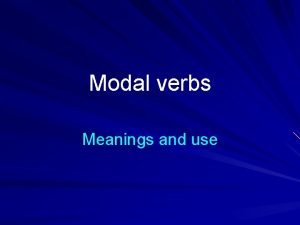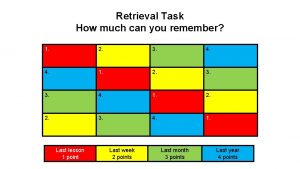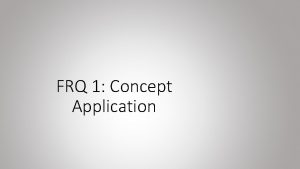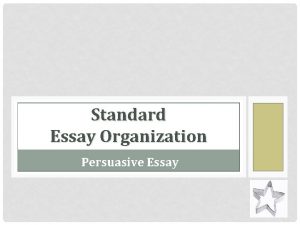FRQ You can do it FRQ Essay part



















- Slides: 19

FRQ You can do it!

FRQ • Essay part of AP Psychology Exam • Two FRQs to respond to with the allotted 50 minutes (25 minutes each)

Here’s what one looks like… • Psychology is the scientific study of behavior and mental processes. The field of psychology is diverse and looks at behavior and mental processes in various ways. Explain how each term below applies to the study of psychology, citing key figures and studies where necessary. Next, discuss the differences for each pair of terms (a-b, c-d, e-f) a. b. c. d. e. f. Functionalism Structuralism Cognitive Approach Neuroscience Approach Experimental Psychology Clinical Psychology

Hints… • Identify the number of “points” that you think the question is worth. Usually, each aspect of the question is worth one “point”. Questions may range from approximately 7 -10 points. • No introduction or conclusion • Answer question in detail and full sentences

Hints… • Provide as much relevant detail as possible! • • • Psychological figures Concepts Terms Methods Theories Examples

Hints… • AVOID abbreviations. If you feel that you need to abbreviate, first write the word, followed by an abbreviation (e. g. Independent Variable (IV)). Continue to use the abbreviation for the rest of your response.

Hints… • Write neatly. • Practice better handwriting. • Scorer is more likely to award you points if he/she is easily able to understand what you are communicating. • Underline each “point” as you respond to each aspect of the question.

SODAS Acronym for key FRQ Tips • Space • Order • Define • Apply • Synonyms

SODAS • Space! Leave about 5 lines blank between each separate component of your answer.

SODAS • Order Answer the components (often presented in bullets) in the same sequence that they are listed in the question.

SODAS • Define Briefly explain each concept using specific terms

SODAS • Apply to the scenario Relate the term to the scenario or connect terms as directed. – Each example must reference the specific situation

SODAS • Synonyms Do not use the term itself in the definition or application alone. Use a synonym!

SODAS • Synonyms WRONG - Chunking involves placing a large amount of items to be memorized into chunks in order to increase short-term memory capacity. CORRECT – Chunking involves placing a larger amount of items to be memorized into small groups in order to increase short-term memory capacity.

Let’s Practice… • George is said to have an “easy-going” personality. How might the biopsychosocial approach be used to explain an easy-going personality?

Let’s Practice… • George is said to have an “easy-going” personality. How might the biopsychosocial approach be used to explain an easy-going personality? ØBiological ØPsychological ØSociocultural

Let’s Practice… • George is said to have an “easy-going” personality. How might the biopsychosocial approach be used to explain an easy-going personality? Biological factors would include George’s genetic, phsyiological, and chemical makeup. For instance, George’s easy-going manner may be the result of brain chemistry.

Let’s Practice… • George is said to have an “easy-going” personality. How might the biopsychosocial approach be used to explain an easy-going personality? Psychological factors would include a discussion of how George learned that an easy-going personality makes people want to spend time with him. In response, he keeps anxiety and negative feelings to himself. He has the perception that others do not want to deal with his stress and anxiety.

Let’s Practice… • George is said to have an “easy-going” personality. How might the biopsychosocial approach be used to explain an easy-going personality? Social-cultural factors would include George’s family or cultural upbringing and expectations. If those who surround George expect him to be relaxed and laid-back, and this is what is supported in his community. George will be likely to act accordingly.
 If you think you can you can poem
If you think you can you can poem If you can imagine it you can achieve it
If you can imagine it you can achieve it If you can't measure it, you can't manage it
If you can't measure it, you can't manage it If you can't measure it you can't manage it
If you can't measure it you can't manage it You cant manage what you cant measure
You cant manage what you cant measure Langfristiges fremdkapital
Langfristiges fremdkapital You can tell harris about it just ____(easily) as i can.
You can tell harris about it just ____(easily) as i can. You can tell harris about it just ____(easily) as i can
You can tell harris about it just ____(easily) as i can Kinds of degree
Kinds of degree I know nothing is impossible
I know nothing is impossible You can't turn right here you turn left
You can't turn right here you turn left Have a daughter so you can argue
Have a daughter so you can argue Jared peet
Jared peet Standardasation
Standardasation Alan and susie an argument
Alan and susie an argument Go straight ahead or turn right
Go straight ahead or turn right You can be just the one you wanna be
You can be just the one you wanna be I can hear you quite well. you not shout
I can hear you quite well. you not shout So you think you can argue
So you think you can argue Check if you can remember what tim tells you
Check if you can remember what tim tells you





































